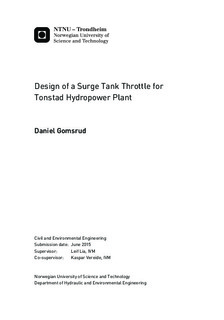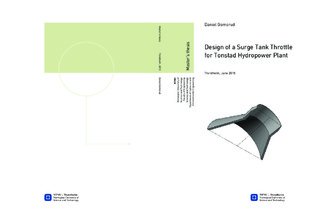| dc.description.abstract | The objective of this thesis has been to evaluate the effect of throttling the surge tanks at Tonstad Hydropower Plant, by the means of one-dimensional numerical modelling in the program LVTrans. The background of the thesis is problems with the amplitude of mass oscillations in the surge tanks at Tonstad, causing restrictions on operation, due to the fear of drawing the surge tank water level down to a level where air enters the sand trap and initiates free surface flow.
The numerical model of Tonstad hydropower plant, used for simulations, is currently running as a superset regulator at the plant. The calibration and validation shows good representation of steady state operation and period of mass oscillations. The amplitude of mass oscillations, does however show high deviations that are attributed to the inaccurate representation of transient friction in the numerical method. The simulations are interpreted relatively to minimise the error from the numerical model to the prototype, meaning that throttle effect is evaluated on the basis of improvement of mass oscillation amplitude from the restricted surge tank steady state water level. The critical situation for drawdown at this restriction level has been found to be with an output effect of 660 MW, reservoir levels at 482 m.a.s.l. in Homstøl and Ousdal, 49.5 m.a.s.l. in Sirdalsvann and with no inflow of water to the creek intakes.
An optimization of throttle losses was performed by comparing a simulation of the current situation with simulations with varying throttle losses. The throttles asymmetric geometry was calculated from tabular values. The optimization finds that an asymmetric throttle, with loss ratio 1:1.5 from upwards to downwards flow respectively, may reduce downswing of the water level by 9.6 meters. A simulation where the restriction level in the surge tanks is reduced by 8 meters, show that the surge tank water level downswing is further reduced by 5.3 meters. It is concluded that the optimized throttle allows for a reduction of the restricted water level in the surge tank from 470 to 462 m.a.s.l., provided that all reservoir gates are fully open and water level at Ousdal is equal or higher than the water level at Homstøl. Some uncertainties connected with the numerical model are high, but these are outweighed by several conservative assumptions made in the simulations.
The annual economic loss due to restricted operation is estimated to 2.5 million NOK, resulting in an allowed throttle cost of 33.3 million NOK to ensure profitability. The evaluation of surge tank throttling at Tonstad Hydropower Plant exemplifies benefits that may be achieved by detailed surge tank throttle design at other high head hydropower plants. | |

